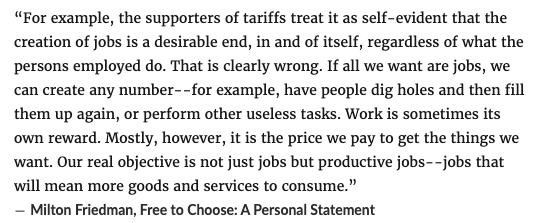Mamdani, Trump, and Milton Friedman
- or -
How to Annoy Literally Everyone at Thanksgiving
Today's Agenda
- Review of why the neoclassical model says free markets are great
- Analyze two very anti-free-market policies
- Trump tariffs
- Mamdani rent control
- Try as hard as we can to make the economic case for why these might not be terrible ideas
FIRM
CONSUMER
Net benefit from buying \(Q\) units at price \(P\):
Net benefit from selling \(Q\) units at price \(P\):
Total welfare:
Marginal welfare from producing another unit:
profit-maximizing
firms set P = MC
utility-maximizing consumers set P = MB
as long as consumers and firms face the same price, markets set MB = MC and maximize total welfare!
Remember what happened in market equilibrium:
1. Consumer Optimization: each consumer \(i\) is consuming a quantity \(x_i^*(p^*)\) that solves their utility maximization problem.
2. Firm Optimization: each firm \(j\) is producing a quantity \(q_j^*(p^*)\) that solves their profit maximization problem.
3. Market Clearing: the total quantity demanded by all consumers equals the total quantity supplied by all firms.
Note: if we go back to the individual demand
and supply functions, we get:
What does an omniscient "social planner" do?
Productive Efficiency:
Allocate production so that each firm has the same marginal cost of making the last unit.
Don't overproduce or underproduce.
Allocative Efficiency:
Allocate consumption so that each person gets the same marginal utility from the last unit.
Ensure that the last unit consumed brings the same
marginal benefit to each consumer as the marginal cost it requires to produce.
What occurs in market equilibrium?
Firm Optimization:
Every firm produces up until the point where their marginal cost equals the market price (MC = P)
Market clearing: supply equals demand.
Consumer Optimization:
Every consumer buys up until the point where their marginal benefit equals the market price (MB = P)
Consumers and producers all face the same market price
"Individual ambition serves the common good." - Adam Smith
If there is a single price in the market that all consumers pay, and all producers receive, and all consumers and producers are “price takers,” then:
Every consumer sets MB = P:
- Everyone’s MB from the last unit bought is the same.
- Cannot increase total benefit by reallocating the good from one consumer to another
Every firm set MC = P:
-
Every firm’s MC from the last unit produced is the same.
-
Cannot reduce total costs by reallocating production from one firm to another
The MB of the last unit consumed by some person
equals the MC of the last unit produced by some firm
All of this begs the question:
if we've proved that the free market is so wonderful, why are so many people dissatisfied with its results?


Policy I: Tariffs
So, let's put aside manufacturing jobs.
Let's also state clearly that a tariff is a tax.
But let's say that Trump follows through on a promise he made on social media recently: to send a $2000 divided to every American except high-income people.
Could this be a net positive?
Policy II: Rent Control



But wait...don't prices reflect what people want?

NOTATION AHEAD
STAY FOCUSED ON
ACTUAL ECONOMICS
Special Case: Cobb-Douglas
Suppose each consumer has the utility function
where the \(\alpha\)'s all sum to 1.
We've shown before that if consumer \(i\)'s income is \(m\), their demand for good \(k\) is
quantity demanded of good \(k\) by consumer \(i\)
consumer \(i\)'s preference weighting of good \(k\)
consumer \(i\)'s income
price of good \(k\)
There are 200 people, and they each have \(\alpha = \frac{1}{2}, m = 30\)
Suppose there are only two goods, and each consumer has the utility function
So consumer \(i\) will spend fraction \(\alpha_i\) of their income \(m_i\) on good 1:
Market demand:
number of consumers
quantity demanded by each consumer
Note: total income is \(200 \times 30 = 6000\), so this means the demand is the same "as if" there were one "representative agent" with \(\alpha = \frac{1}{2}, m = 6000\)
Individual demand:
Now suppose there are two types of consumers:
Again there are only two goods, and each consumer has the utility function
100 low-income consumers who don't like this good: \(\alpha_L = \frac{1}{4}, m_L = 20\)
100 high-income consumers who do like this good:\(\alpha_H = \frac{3}{4}, m_H = 40\)
(demand from
low-income)
(demand from
high-income)
Market demand:
Individual demand:
Note: total income is \(100 \times 20 + 100 \times 40 = 6000\), so this means the demand is the same "as if" there were one "representative agent" with \(\alpha = \frac{7}{12}, m = 6000\)
Conundrum
In both cases, average income was 30 and average preference parameter \(\alpha\) was \(\frac{1}{2}\).
When everyone was identical, it was "as if"
there was a representative agent with all the money
with preference parameter \(\alpha = \frac{1}{2}\).
When rich people had a higher \(\alpha\), it was "as if"
there was a representative agent with all the money
with preference parameter \(\alpha = \frac{7}{12} > \frac{1}{2}\).
Feel free to tune out the intermediate steps, but hang on to the econ...
How market demand aggregates preferences
If consumer \(i\)'s demand for good \(k\) is
then the market demand for good \(k\) is
where \(M = \sum m_i\) is the total income of all consumers
and \(\alpha_k\) is an "aggregate preference" parameter.
Conclusion: we can model demand from \(N_C\) consumers with Cobb-Douglas preferences
"as if" they were a single consumer with "average" Cobb-Douglas preferences.
so what is \(\alpha_K\)?
If everyone has the same income (\(m_i = \overline m\) for all \(i\)), then demand simply aggregates preferences:
Let \( \overline m = M/N_C\) be the average income. Then we can rewrite market demand as:
\(\alpha_K\)
But if there is income inequality, \(\alpha_k\) gives more weight to the prefs of those with higher income.
\(=1\)
Example: consider an economy in which rich consumers like a good more:
100 low-income people with \(\alpha_L = \frac{1}{4}, m_L = 20\),
100 high-income people with \(\alpha_H = \frac{3}{4}, m_H = 40\)
Average income is \(\overline m = 30\), total income is \(M = 6000\)
So, market demand is
closer to \(\alpha_H\) than \(\alpha_L\)
Example, revisited
What does Trulia say?
Conclusion: Aggregating Preferences
You can model market demand as reflecting the preferences of a single representative agent.
But...know that you're weighting the preferences of richer people more.
Mamdami, Trump, and Milton Friedman
By Chris Makler
Mamdami, Trump, and Milton Friedman
Welfare Analysis of Equilibrium
- 29



